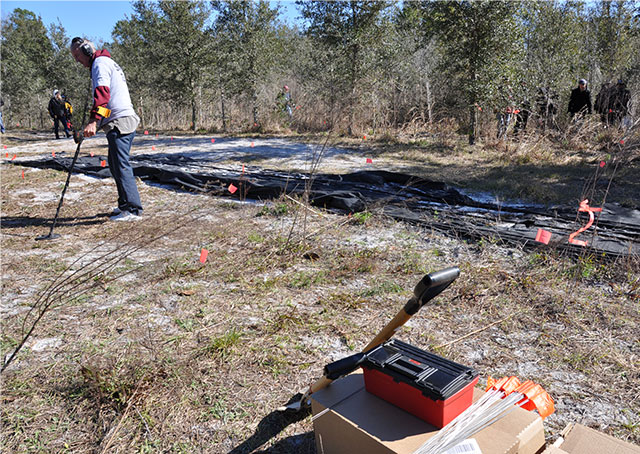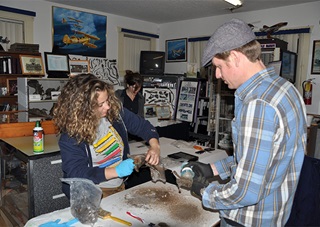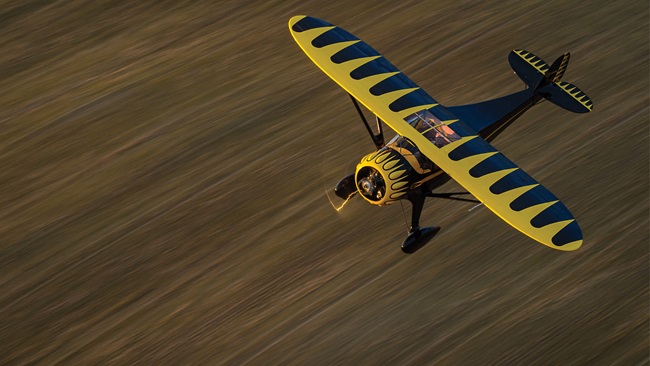
Little of the airplane was left, and the pieces were small: hundreds of fragments, none larger than a foot across—a mysterious crash in central Florida, seven decades in the past.
U.S. Navy personnel and volunteers responded to a metal detector enthusiast’s discovery with an archeological team, unearthing more fragments Feb. 18 through 20 in Osteen, an unincorporated community on flat ground dotted with lakes. The site is about 15 miles southeast of DeLand Municipal Airport, formerly a Naval Air Station and tentatively identified as the airport from which the flight launched, and to which it never returned.
A two-inch square metal fragment etched with “SBD-5” put Naval History and Heritage Command archaeologist George Schwarz on the trail of one particular aircraft and one lost pilot who was among thousands who trained at DeLand Naval Air Station between 1942 and 1946. Many have joined the effort to rule out the possibility an airman remains lost to his family, and to history. Lt. Cmdr. Heidi Lenzini of the Naval History and Heritage Command, who joined the expedition to Osteen and has researched the case, said there are signs that point to a known crash from which the pilot and much of the aircraft were recovered soon after the SBD went down.
“The archaeologist (Schwarz) is getting more comfortable with saying this is the one,” Lenzini said, noting that great care is being taken with the still-pending confirmation. The pilot believed to have been alone at the controls was not far along in training when he crashed and lost his life.
Many other aviators left DeLand and similar air stations around Florida to accomplish great things, and the Douglas SBD Dauntless earned a place of honor among the great warbirds of World War II. Known for being tough, dependable, and stable in a dive, it took on Japanese aircraft and ships in the Pacific. (AOPA Pilot Senior Editor Dave Hirschman wrote about his own experience as a civilian SBD pilot in command in 2011.) SBDs stationed on aircraft carriers attacked and sank four Japanese carriers at the Battle of Midway, dealing a devastating blow that halted the Japanese Imperial Navy’s once-rapid expansion. Plunging into dives as steep as 70 degrees, SBD pilots could release 2,250 pounds of bombs with accuracy, the precision weapons of their day. They were built to take punishment, protecting their crews from enemy fire far better than the aircraft of their adversaries, and used the brawn of a flying tank powered by a 1,000-horsepower Wright radial engine to destroy more agile but lightly armored foes in the air. Against ships, SBD pilots braved withering fire to attack from above, releasing bombs that would often pierce the deck and explode inside the targeted ship.

It may forever remain unclear exactly why the aircraft crashed in Osteen, a high-energy wreck that scattered small pieces found by local resident Rodney Thomas using his new metal detector. The discovery made him wonder if an airman was still missing. Thomas reached out to volunteer Scott Storz at the DeLand Naval Air Station Museum in search of answers. The end result was Schwarz and a team of about 45 volunteers from nearly a dozen organizations, all converging on the location in hope of unearthing an answer. K-9 Search and Rescue of Orange County teams were among the assets deployed, their dogs trained to detect human remains, though none were found.
The search was methodical, with GPS used to log the location of each fragment. Lenzini said it did not come as much of a surprise that no large pieces were found, given both the age of the wreckage and the likelihood that Navy personnel found it long ago, and would have recovered not only the pilot.
“Anything salvageable they would have used for parts,” Lenzini said, noting that detail had been confirmed by one who was there at the time: Ken Torbett, 94, who worked at DeLand NAS as a crew chief, described for the investigators the protocol for search, rescue, recovery, and reuse of then-scarce parts.
Thirty of the volunteers who joined Schwarz on site were from the Central Florida Metal Detecting Club; graduate students studying archaeology at the University of West Florida also arrived to assist, along with representatives from the Lighthouse Archaeological Maritime Program and Florida Public Archaeology Network. Together, they found and carefully documented many pieces, all of which will be examined and cataloged. A manual located in the National Archives is helping the team identify specific parts. Schwarz will eventually document his findings in a report, closing the book on one of 25 known dry-land crashes involving an SBD out of DeLand NAS during the war years.
Lenzini’s own account, published by the Navy History and Heritage Command, is available online.



